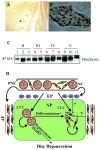Toward an understanding of the role of notochordal cells in the adult intervertebral disc: from discord to accord
- PMID: 20568241
- PMCID: PMC3634351
- DOI: 10.1002/dvdy.22350
Toward an understanding of the role of notochordal cells in the adult intervertebral disc: from discord to accord
Abstract
The goal of this mini-review is to address the long standing argument that the pathogenesis of disc disease is due to the loss and/or the replacement of the notochordal cells by other cell types. We contend that, although cells of different size and morphology exist, there is no strong evidence to support the view that the nucleus pulposus contains cells of distinct lineages. Based on lineage mapping studies and studies of other notochordal markers, we hypothesize that in all animals, including human, nucleus pulposus retains notochordal cells throughout life. Moreover, all cells including chondrocyte-like cells are derived from notochordal precursors, and variations in morphology and size are representative of different stages of maturation, and or, function. Thus, the most critical choice for a suitable animal model should relate more to the anatomical and mechanical characteristics of the motion segment than concerns of cell loss and replacement by non-notochordal cells.
Figures



References
-
- Adams DS, Keller R, Koehl MA. The mechanics of notochord elongation, straightening and stiffening in the embryo of Xenopus laevis. Development. 1990;110:115–30. - PubMed
-
- Agrawal A, Guttapalli A, Narayan S, Albert TJ, Shapiro IM, Risbud MV. Normoxic stabilization of HIF-1alpha drives glycolytic metabolism and regulates aggrecan gene expression in nucleus pulposus cells of the rat intervertebral disk. Am J Physiol Cell Physiol. 2007;293:C621–31. - PubMed
-
- Aguiar DJ, Johnson SL, Oegema TR. Notochordal cells interact with nucleus pulposus cells: regulation of proteoglycan synthesis. Exp Cell Res. 1999;246:12. - PubMed
-
- Ang SL, Rossant J. HNF-3 beta is essential for node and notochord formation in mouse development. Cell. 1994;78:561–74. - PubMed
Publication types
MeSH terms
Grants and funding
LinkOut - more resources
Full Text Sources
Other Literature Sources

